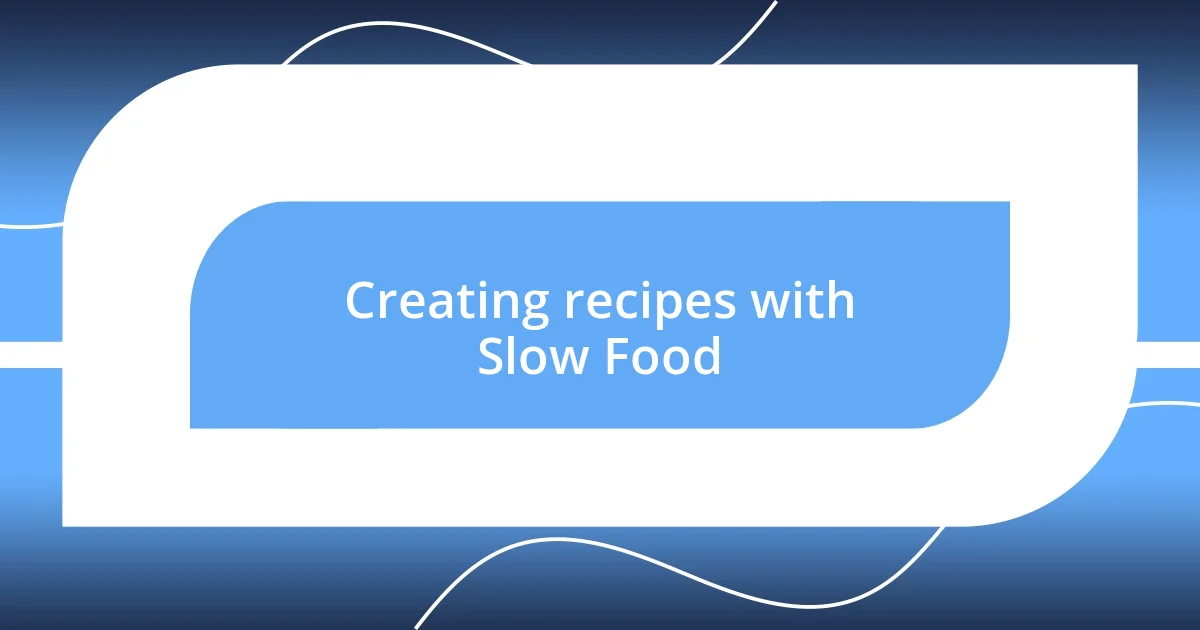Key takeaways:
- The Slow Food movement emphasizes local traditions, sustainable practices, and mindful consumption, fostering a deeper connection to food and community.
- Key principles include biodiversity, traditional culinary techniques, and mindful consumption, encouraging appreciation for local ingredients and cultural heritage.
- Building a Slow Food community involves sharing meals, participating in workshops, volunteering, and creating recipes that tell stories, promoting a sense of connectedness and cooperation.

Understanding the Slow Food movement
The Slow Food movement is about more than just enjoying food; it’s a celebration of local traditions and sustainable practices. I still remember my first time visiting a local farmer’s market, surrounded by vibrant produce and the passionate stories of the growers. How wonderful it felt to connect with the people behind the food I was about to eat!
At its core, Slow Food champions an appreciation for the origins of our meals, urging us to consciously choose what we consume. Have you ever stopped to consider where your ingredients come from? I’ve found that buying locally not only supports the community but also often results in fresher, tastier meals. It’s a simple yet powerful way to foster a deeper connection with our environment.
Moreover, the movement encourages us to slow down and savor each bite, promoting mindfulness in our eating habits. I recall a time when I hosted a dinner party, focusing on each course made from slow food ingredients. The conversations flowed more freely, and we all felt more present. Don’t you think this intentional approach can transform our daily meals into meaningful experiences?

Principles of Slow Food practices
The principles of Slow Food practices resonate deeply with my own culinary journey. One key aspect is the commitment to biodiversity, which champions the rich variety of crops and livestock native to different regions. I still vividly remember trying a local heirloom tomato for the first time; its flavor was a delightful revelation that made me appreciate the diversity offered by nature. This focus on unique, local ingredients fosters not just a connection to place but a respect for the environment.
Another principle is the emphasis on traditional culinary techniques. Each time I attempt an age-old recipe passed down through generations, I feel a sense of belonging and continuity with my cultural heritage. For instance, making sourdough bread using a starter from a neighbor helped create a sense of community. It’s fascinating how these practices link us to our ancestors, making every meal a piece of history.
Lastly, I’ve come to realize that Slow Food encourages mindful consumption. This principle has led me to critique my eating habits and prioritize quality over quantity. There was a moment when I decided to switch from store-bought snacks to preparing my own, paying attention to ingredients and savoring each taste. Have you ever stopped and truly tasted your food? The slow approach allows me to appreciate flavors I might have otherwise rushed through.
| Principle | Description |
|---|---|
| Biodiversity | Emphasizes the variety of local crops and livestock, enhancing environmental respect. |
| Traditional Techniques | Focuses on culinary methods passed down through generations, connecting us to our heritage. |
| Mindful Consumption | Encourages savoring food with intention, valuing quality over quantity. |

How to source local ingredients
Sourcing local ingredients has transformed my cooking experience in remarkable ways. One day, while exploring a small roadside farm stand, I stumbled upon the most vibrant greens I had ever seen. The farmer was more than happy to share his growing practices, which made me realize how much I appreciated knowing exactly where my food was coming from. This direct connection to the source deepens my appreciation for the meals I prepare.
To successfully source local ingredients, consider these strategies:
- Visit farmers’ markets regularly; the atmosphere alone is invigorating!
- Join a community-supported agriculture (CSA) program to receive seasonal produce.
- Connect with local farmers online; many have social media pages to share updates.
- Explore local specialty grocery stores that prioritize regional products.
- Participate in local food co-ops for a diverse range of local goods.
Engaging with these sources not only enriches my plate but also creates a sense of community. Just the other week, I met a fellow cooking enthusiast at a market, and we ended up swapping recipes and tips. It’s amazing how sourcing locally opens doors to new friendships and culinary collaborations.

Building a Slow Food community
Building a Slow Food community goes beyond just sharing meals; it’s about cultivating relationships. I remember hosting a potluck last summer, where each dish came with a story shared by its maker. The conversations flowed effortlessly, leaving me with a warm feeling of connectedness to those around me. Have you ever experienced the joy of gathering over food that wasn’t just yours? It’s a beautiful reminder that food can facilitate bonds we might not have otherwise formed.
Participating in local workshops is another way to strengthen this community. I once attended a cheese-making class led by a local artisan. As we molded curds and shared techniques, it became clear that learning together fostered a spirit of camaraderie. By sharing skills, we not only preserve traditional practices but also create lasting friendships. What could be more rewarding than skill-sharing that contributes to both personal growth and community development?
Volunteering for local initiatives is also key to building a Slow Food community. I spent a Saturday planting an edible garden at a nearby school, and seeing kids marvel at the vegetables they planted was simply heartwarming. It reminded me of how food can serve as an educational tool, igniting curiosity about where our meals originate. Isn’t it vital to engage the younger generation in the Slow Food movement? These grassroots efforts instill a sense of responsibility and connection to food that can last a lifetime.

Creating recipes with Slow Food
Creating recipes with the Slow Food philosophy is an enlightening experience that encourages creativity and a deep connection to the ingredients. Recently, I experimented with a simple seasonal vegetable soup using fresh produce from a local CSA. As I chopped organic carrots, tomatoes, and herbs picked that very morning, I felt an overwhelming sense of gratitude for the flavors each vegetable could bring. I often find myself pondering, how can something so simple bring so much joy?
In my kitchen, crafting recipes becomes a mindful process. For instance, I recall an afternoon spent making homemade pasta from scratch—a task that initially felt daunting but ultimately turned into a joyful ritual. As I kneaded the dough, the aroma of flour enveloped me, and I thought about generations of cooks who have cherished this process. What if each time we prepare a meal, we also cultivate a moment of reflection on our food traditions?
I love to incorporate storytelling into my recipes, connecting them to the ingredients’ origins or the people who grew them. For instance, writing a recipe for honey-roasted root vegetables once led me to think about the local beekeeper and his passion for sustainability. Including a note about his farm in the recipe made the dish feel special, almost sacred—like a piece of our local heritage. Don’t you think that every recipe can tell a story, inviting those who taste it to experience a slice of our community?

Sustaining the Slow Food lifestyle
Sustaining the Slow Food lifestyle isn’t just about the food; it’s about the practices we embrace daily. I remember one Sunday morning when I decided to visit a nearby farmer’s market instead of the usual grocery store. As I wandered through the aisles of sun-ripened tomatoes and fresh-baked bread, the vibrant colors and welcoming smiles of the farmers sparked a joy in me that was utterly refreshing. Isn’t it amazing how choosing local not only supports our community, but also enriches our palates?
I believe that maintaining my own kitchen as a Slow Food sanctuary is another crucial aspect. Each week, I set aside time to prepare meals that honor the seasonality of ingredients. One evening, as I made a hearty ratatouille with vegetables from my garden, I felt a sense of fulfillment knowing that my meal was both nourishing and sustainable. Have you ever noticed how much tastier food is when you know exactly where it came from?
Moreover, sharing my knowledge with friends and family is a way to extend the Slow Food philosophy. I often host cooking nights, where we learn together more about traditional preservation techniques, like canning or fermenting. It’s rewarding to see how engaged my friends become; watching them discover the satisfaction of making something from scratch amplifies my own appreciation. What better way to keep this movement alive than by empowering others to join in on the journey?














